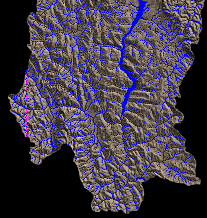Aquatic Invertebrates of Montana
Kootenai River Drainage- Montana
This drainage starts far to the North in British Columbia. In Montana, it is essentially the area of Lincoln County in the far northwest corner of the state. Most of the land belongs to the Kootenai National Forest. The Flathead River borders to the east and the Clark Fork River borders to the South. The USGS has much of the gaging station data online.
Tubifex Summary
As of February 13 I have just 8 samples from this drainage and I have prepared 53 slides and closely examined 318 worms. There are likely many areas without Tubifex in this drainage.
Mainstem
I have only 2 samples from the mainstem. A late August quantitative sample (90) near Ripley took 473 worms per liter. Two of the 30 worms that were mounted could be Tubifex, but they were very immature. A large qualitative sample (200) in September just below Libby Dam took many worms, but with no sign of Tubifex. This river is clearly not as Tubifex-loaded as most tailwaters in Montana, but more samples are needed before feeling too sure that Tubifex is really rare here. The invertebrate community in the river is certainly typical of many sites that are loaded with Tubifex.
Tributaries
Most of small, high gradient mountain forest streams in this drainage are fairly intact with rich benthic communities. Most of these streams should be free of Tubifex, but only a few have been specifically sampled for worms, so far. Tubifex is known only in the Fisher River, but it might also occur in some of the other impacted streams.
- Fisher River- A mid-September sample near the mouth (311) took many worms and mostly (69%) Tubifex.
This is the only Tubifex positive site yet known in the drainage. Ilyodrilus templetoni
also occurs here indicating warmer water and making the identification of small immature
worms impossible. While most of the tubifex were immature at this time, they were
far too big to be Ilyodrilus. This river has a rich community in the riffles, but
the large, unnatural mud-bars make room for Tubifex to fit in. Sediment loading is
an obvious problem in this river, but I am not sure of the causes. The shifting river
recently took out much of the nearby road.
- Bull Lake- An April sample near the Bad Medicine boatramp took only Limnodrilus hoffmeisteri.
Tubifex is normally absent in the shallow water of lakes.
- Lime Creek at Treso- This is a historical sample (23) collected by T. Hall in 1975. It contained some
interesting large lumbriculids, but no Tubifex. I known nothing else about this sample
or the stream.
- Yaak River- Two samples from Yaak Falls (99 and 302) actually took some tubificids, but no Tubifex.
This is probable not the best place to look for Tubifex, but the river seems unlikely
to have Tubifex anywhere.
- 17 mile Creek- A mid-summer large sample near the North Fork (320) took virtually no oligochaetes, but 1 immature specimen could be Tubifex. There was little evidence to suggest that Tubifex should occur here, but summer samples can be unreliable.
Aquatic Oligochaete species list
- Lumbricidae prob. Eiseniella tetraedra (Savigny)
- Rhynchelmis sp.
- Ilyodrilus templetoni (Southern)
- Limnodrilus hoffmeisteri Claparede
- Tubifex tubifex (Muller)
- Rhyacodrilus montana (Brinkhurst)
- Chaetogaster sp.
- Uncinais uncinata (Orsted)
- Specaria? sp?
Whirling Disease Risk Assessment
Whirling disease is not yet reported in this drainage. The Kootenai River itself requires more sampling before the whirling disease risk in the mainstem is discounted. So far, only the lower Fisher River is known to be at high risk. The upstream extent of Tubifex in the Fisher River is not yet known, but there are reasons to expect a fairly wide distribution there. Even in the lowest parts of the river, Tubifex is limited to areas with excessive sediment deposits.
Some of the more "civilized" streams such as the Tobacco River, Libby Creek, and Lake Creek might have higher risks. I already known Libby Creek and Lake Creek pretty well and would be a little surprised to find Tubifex in them. The Kootenai drainage has an abundance of small, fairly intact streams that should have very low risk for the disease. The high gradients and high spring flows probably lessen the risk of many streams.
Tubifex Research Needs and Opportunities
That the Kootenai River mainstem is not filled with Tubifex is cause for further study. The selective withdraw structure on the dam which allows it to mimic a more normal temperature pattern might deserve the credit, but this is not because it saved the rivers normal community of insects. The community here is very poor in species. Variation in flow, temperature or water chemistry must be involved.
This drainage needs much more basic survey work. Obviously missing are the Tobacco River, Libby Creek, and Lake Creek. More work on the upper parts of the Fisher River and its tributaries is also needed.
10 Feb 1997, updated on 26 FEB 1997, D.L. Gustafson
Back to the Montana Tubifex Summary by River System
AIM home page
dlg@rivers.oscs.montana.edu


